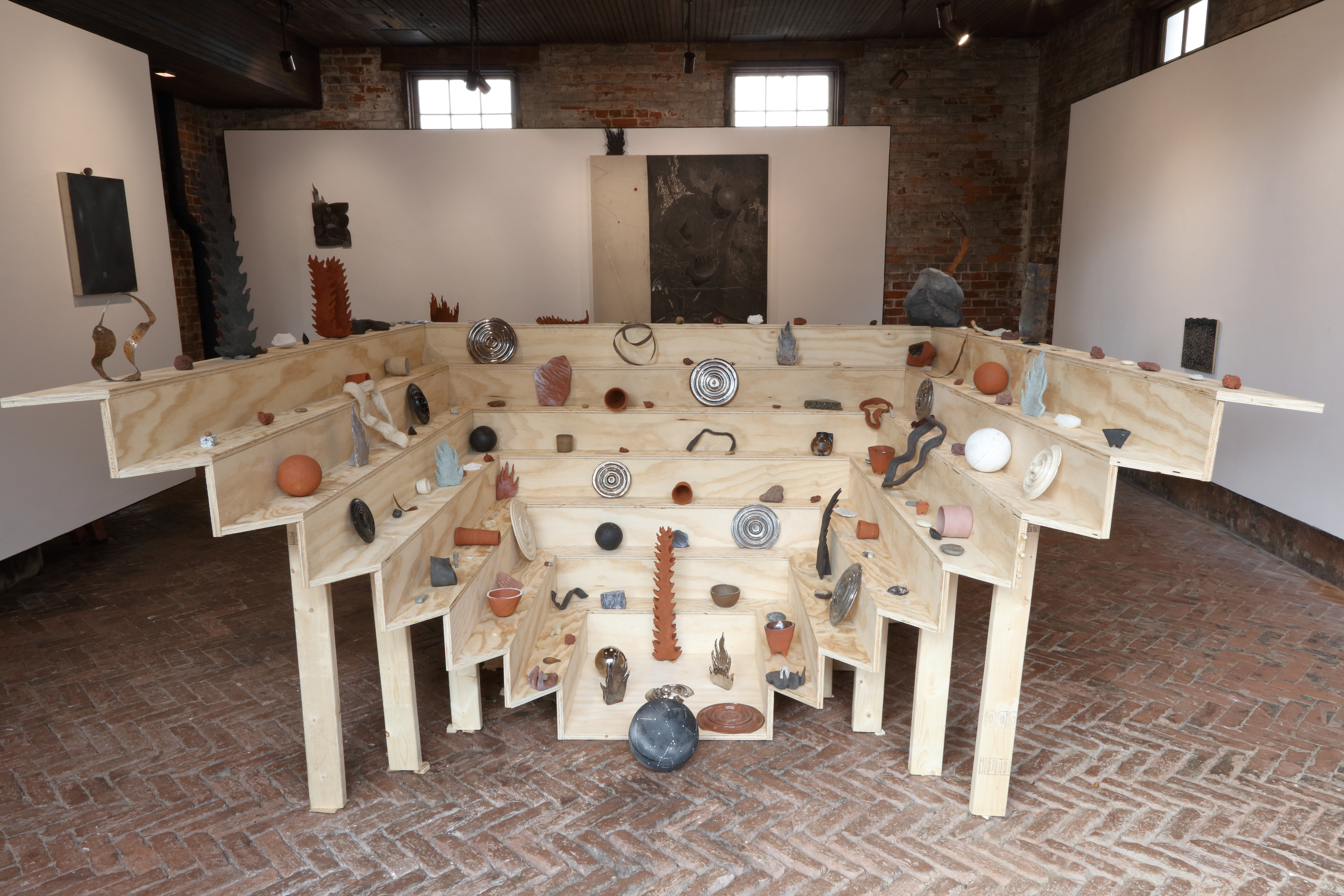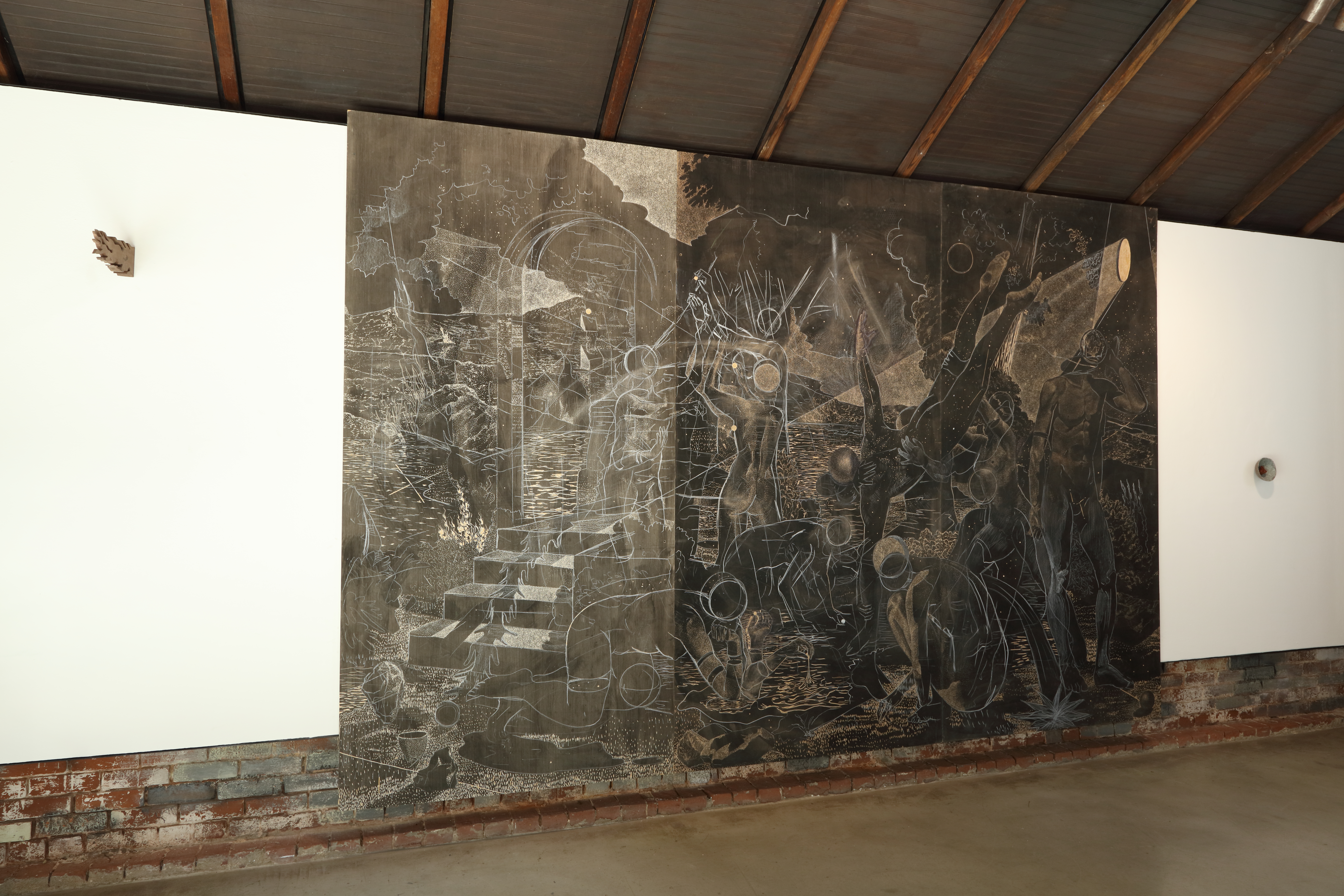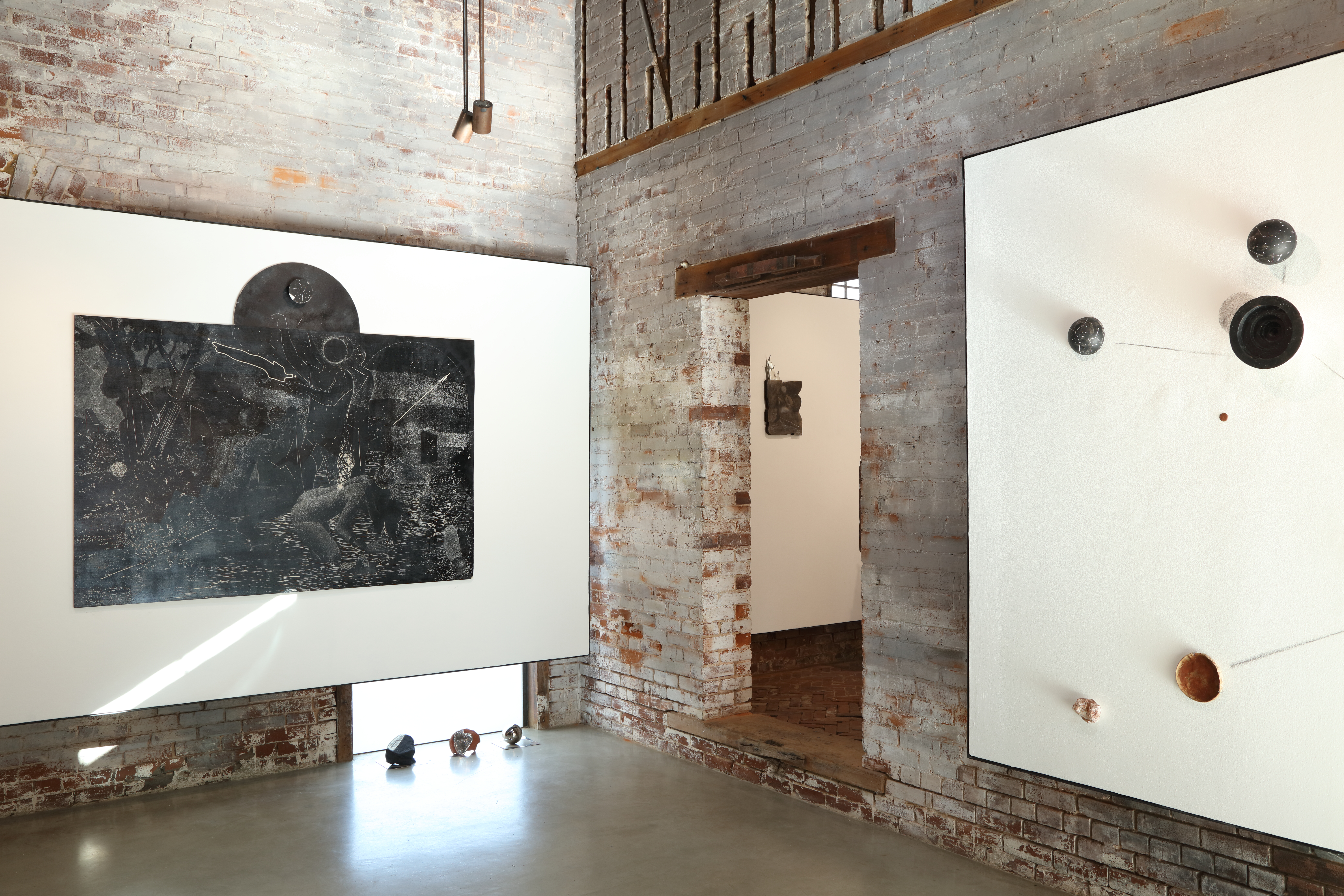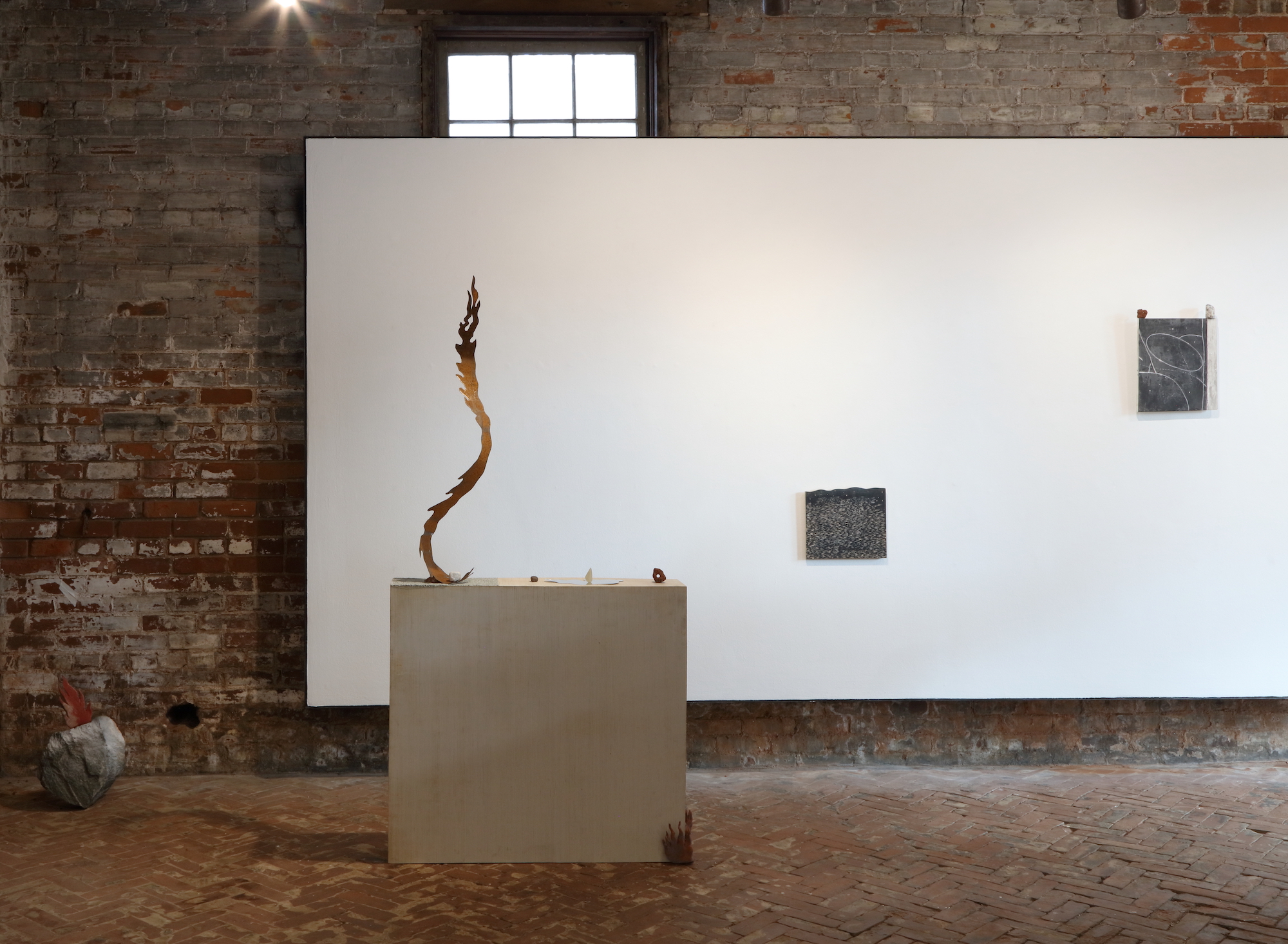Fuego Nuevo —Sergio Suárez

Sergio Suárez, Principles of Division , 2020-2022, wood, white gold luster, ceramic, stone, marble, hydrocal, stoneware, latex, steel, charcoal, and found objects on custom wooden pedestal [photo: Mike Jensen; courtesy of the artist and Whitespace Gallery, Atlanta]
Share:
Through a combination of printmaking, ceramics, and installation, Sergio Suárez uses distinct traditional techniques to assemble a visual language, one that examines the fusion, impermanence, and consistency of objects, images, and structures. The exhibition is framed by the Meso-American, post-classical-period ceremony Fuego Nuevo (New Fire)—a ritual enacted every 52 years to ensure that the sun would return, thus staving off the end of the world. Suárez divides the exhibition into “the preparation,” in the gallery’s first room, and the “conclusion,” in the second room. Fuego Nuevo (New Fire) is a busy yet compelling exhibition at whitespace gallery in Atlanta. Demonstrating a meticulous work ethic, Suárez finds beauty, violence, and occasional whimsy in ritualistic processes. But the abundance of objects on display oversaturates Suárez’s visual language, resulting in a cacophony that, at times, gets lost in translation.
Upon entering the gallery dedicated to “the preparation,” I was enchanted by works reminiscent of Suárez’s ongoing output: various-sized, inked woodcut panels depicting an abundance of black-and-white, dynamic compositions charged with narrative drama. Procedures to Ease the Fall (2021–ongoing), a large-scale three-panel woodcut, dominates one side of the room. The trio of towering matrixes places viewers in the foreground of an impending ritual. The figures depicted labor on and around fragmented architectural structures, handling numerous items such as hearthstones, vessels, and other household objects. In the Fuego Nuevo ceremony, participants would prepare days in advance of the event to free themselves from physical manifestations of their old lives and plan for the new one to come. Procedures to Ease the Fall portrays this moment with motifs that recur throughout the exhibition: fires; cups; rocks; and anonymizing, orb-like heads. Although the details for a fully rendered woodcut are present, the work has a sketchiness unlike any other woodcut panel or print in the exhibition. This tryptic is a work in progress, but Suárez might have considered including other in-progress pieces to provide the viewer greater context for the large swaths of the composition left uncut. There is appeal and particular value in seeing Suárez’s process, but the ephemeral quality of the areas of as-yet uncarved chalk lines makes this otherwise dominating work’s narrative feel diminished in comparison to the complete carvings in the show’s other works.
Sergio Suárez, Procedures to Ease the Fall, 2021 – ongoing, woodcut matrix, 96 x 144 inches [photo: Mike Jensen; courtesy of the artist and Whitespace Gallery, Atlanta]
On the other side of the room, an array of wall-mounted sculptures in Moment of Suspension (2022) directly mirrors positions of the globular heads of the figures in Procedures to Ease the Fall. The painted half-orbs of plaster and lustrous ceramic pieces scattered across the opposite wall form a constellation-like pattern connected by lines drawn with charcoal. By reflecting the positions of the figures’ circular heads in Procedures to Ease the Fall, Suárez calls forth the ceremony’s astronomical elements, a gesture toward the importance of the cosmos in the ritual. Yet, the choice and use of charcoal—a material easily wiped away, whose lines feel hurriedly drawn—makes the constellation feel trivial compared to the other works. The mirrored constellation offers a powerful gesture, but the importance of the astronomical signs in Fuego Nuevo, described here with the fragility and impermanence of charcoal, begs to be supported by more careful mark-making.
Along the rear wall, Moment of Suspension, a set of three ceramic works are placed in a row on the floor. In the aptly titled … (2022), rock-like and circular forms evoke a whimsical ellipsis, recalling a portion of the ritual wherein the participants must put out their fires and wait in darkness to see if the sun would return. Through this intelligently placed pause between the preparation phase and the ritual itself, Suárez calls for the viewer to mimic the pause—to contemplate before moving into an otherwise more procedural room.
Sergio Suárez, Fuego Nuevo, installation view, 2022 [photo: Mike Jensen; courtesy of the artist and Whitespace Gallery, Atlanta]
In the second space—the “conclusion”—works’ subject matter primarily focuses on fire and the concept of sacrifice. In the Fuego Nuevo ceremony that inspired the exhibition’s title, once the correct alignment of stars appears in the sky, a priest slices open the chest of a human sacrifice, lights a fire there, and then throws their heart in to fuel the fire. Once the fire has been thus forged atop a mountain, it is visible for miles in the darkness. Every viewer, including children, in atonement would cut their ears and toss their blood in the direction of the flame. The fire is then carried, first to temples, then to people’s homes, to celebrate the sun’s return, which ensures the start of a new 52–year cycle.
Suárez’s emphasis on fire is evident throughout the second space. Ceramic fires exist atop canvases and panels, on the floor, on pedestals, on rocks, and even on door handles, mimicking the way the newly lit fire was spread throughout the city. Four flame works, one in each corner of the room, stand out thanks to design, material use, and concept. Quema #1 (2022) includes an intriguing wraparound form in red clay that makes it resemble both a ring of flames and a crown. In another corner, all the fires, the fire (2022), a long, snake-like flame cut from rusted steel, mesmerized me in the way it captures a flame’s movement. This work’s flame also echoes the fiery shadow that cascades down the stairs in Procedures to Ease the Fall. All the fires includes an assembly of small rocks and ceramic pieces next to the main form, but they feel like an afterthought. Like the flame-crown of Quema #1, the metalwork deserves to exist as its own gesture. Almost hidden in the opposite corner, Cusp (2022) is an unexpected video work that can be viewed through a small peephole in the gallery’s rough brick walls. Cusp feels out of place in the best way, thanks to the use of animation and video amid the abundance of woodcuts and ceramics—the small flickering light of the screen peeking through the rough opening in the masonry is an ingenious way to conjure the flame. A singular, final, sculptural flame, Fuego Nuevo II (2022), occupies a corner adjacent to Cusp. The work’s title references the exhibition, its ceremonial inspiration, and also harks back to a protruding wooden flame at the show’s start—this gesture mirrors the process of throwing out the old and embracing the new.
Sergio Suárez, all the fires, the fire,2022, steel, marble soapstone, tezontle and ceramic on wooden pedestal 70 x 35 x 7 inches [photo: Mike Jensen; courtesy of the artist and Whitespace Gallery, Atlanta]
Invocar la noche (To Invoque the night) (2022), a woodcut printed on canvas, arouses a sense of initiation. The image is split: One side shows minimal, muted-color asterisms, whereas the other depicts one figure carrying or dragging another. Connecting the two sides, a sole red-orange line runs between one figure and the asterisms. Al cerrar los ojos (2022), another work on canvas, is one of the only small, hanging pieces in the room that adds to the Fuego Nuevo ceremonial narrative. The work references the moment of complete darkness, when all fires are extinguished in the temples, buildings, and homes, and as the priests wait for the constellation to appear.
Principles of Division (2020–2022) is an installation that resembles an upside-down, stepped pyramid. Three of its outside walls are closed, but walking around to the fourth, open “entrance” reveals a view of its interior, an eight-shelved structure containing more than 60 individual ceramics, metal sculptures, and found objects. At the work’s base, Suárez pairs two ceramic hands with a constellation-covered orb, in a gesture that directly refers to Fuego Nuevo’s ritualistic sacrifice. The number of small works that, together, make up Principles of Division imbues the altar-like installation with a weightiness, but the excess of objects makes it difficult to concentrate on any singular form, and so they are subsumed by the larger gesture.
Sergio Suárez, Principles of Division , 2020-2022, wood, white gold luster, ceramic, stone, marble, hydrocal, stoneware, latex, steel, charcoal, and found objects on custom wooden pedestal [courtesy of the artist and Whitespace Gallery, Atlanta]
Assembling such an ambitious group of woodcuts, ceramics, prints, metalwork, and video represents a massive effort. The superabundance of work often leaves areas of the exhibition feeling overfull. Some works struck me as unnecessary for the exhibition’s overall narrative, or they encompassed repetitive references to the same ideas. Even if the show would benefit from a curatorial edit, though, the artworks in Fuego Nuevo are remarkable. Suárez is an adept storyteller with an abundance of ideas—ones that will only become more realized through this new beginning.
Jacob O’Kelley is an artist and curator in Atlanta. His personal practice navigates the often conflicting relationships between religion, masculinity, queer identity, and memory through painting, sculpture, and installation. He co-founded ShowerHaus, a curatorial co-op, in 2018 and is currently the Creative Director at Swan Coach House Gallery.



